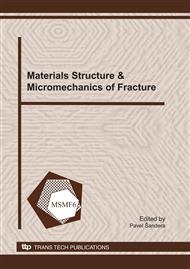p.451
p.455
p.459
p.463
p.467
p.471
p.475
p.479
p.483
Oscillation Marks and Hooks on the Surface of Concast Slabs and their Relation to Breakout
Abstract:
In the secondary-cooling zone, where the slab is beginning to straighten out the breakout of the steel can occur in points of increased local chemical and temperature heterogeneity of the steel, from increased tension as a result of the bending of the slab and also from a high local concentration of non-metal, slag inclusions. Especially dangerous are the changes in the chemical composition of the steel during the actual concasting. In the case of two melts one immediately after the other, this could lead to immediate interruption in the concasting and a breakout. The material, physical, chemical and technological parameters, which both melts differed in were determined. If the dimensionless analysis is applied for assessing and reducing the number of these parameters, then it is possible to express the level of risk of breakout as a function of five dimensionless criteria.
Info:
Periodical:
Pages:
467-470
Citation:
Online since:
January 2011
Keywords:
Price:
Сopyright:
© 2011 Trans Tech Publications Ltd. All Rights Reserved
Share:
Citation:


